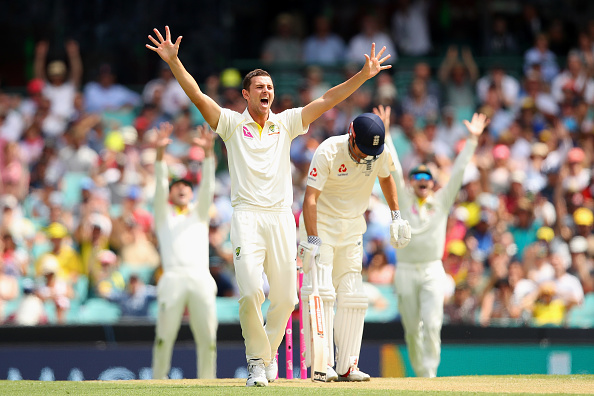 In a surprising instance of a bowler coming up with such an idea, Australian pacer Josh Hazlewood said the International Cricket Council (ICC) should actually consider reducing the number of unsuccessful reviews available as part of the Decision Review System (DRS) to just one per team in each innings in Test match cricket.
In a surprising instance of a bowler coming up with such an idea, Australian pacer Josh Hazlewood said the International Cricket Council (ICC) should actually consider reducing the number of unsuccessful reviews available as part of the Decision Review System (DRS) to just one per team in each innings in Test match cricket.
The ICC recently increased the number of unsuccessful reviews to three per innings from two, given the travelling restrictions amid the COVID-19 pandemic enforcing the use of neutral umpires.
Read Also: "It’s time the DRS was the subject of a thorough overhaul", says Ian Chappell
However, Hazlewood believes that isn't an idea that shall be retained post the pandemic. In fact, the governing body should reduce it to one and push teams into being more judicious with their use of the DRS.
"I'd review them all day if I could but to have a better impact on the game, I think one might work better. If you just had one each per innings then people would use it totally differently," Hazlewood was quoted as saying by cricket.com.au.
"I think umpires can fall into a trap of umpiring a little bit differently depending on who's got reviews left and how many they've got."
"They've got to umpire based on nothing there as well, but if you just had one each you'd save it, you wouldn't use it early unless you were positive and that's what it's there for that howler," he added.
Hazlewood recalled the Ashes 2019 in order to revisit the drama around the DRS that happened at Edgbaston and Lord's. Ten umpiring decisions were overturned on review in the first Test in Birmingham, whereas in the second at the 'Home of Cricket', Australia having used up all its reviews, couldn't ask for a referral to an LBW call against Ben Stokes, whose second-innings 115* put England in the ascendancy in what later turned out to be a drawn encounter.
"After that game (Lord's), we sat down and said, 'Let's put a process in place’. At least we had something to fall back on if we don't know. That was the bowler and the wicketkeeper and someone from the side on come in and we have a quick discussion why wasn't given out," said Hazlewood.
"That's why the square fielder comes in to say, 'The height looked good from my angle'. The keeper (Paine) has a say, and he's obviously the captain as well, so that helps, and we make a quick call then and at least we have a process now we go through."
"If we get them wrong, we get them wrong, but hopefully it goes in our favour. It's not there for the 50-50 calls but when you're in the heat of the battle, you just want to get that wicket and you think it's out at the time," he added.
Australians, however, did use the DRS more out of desperation than awareness again in Headingley, when they referred an LBW call against tailender Jack Leach where the ball pitched outside the leg stump and later had no review left to go upstairs for another one when England's last hope Stokes looked plumb. The visitors eventually succumbed to a defeat.



